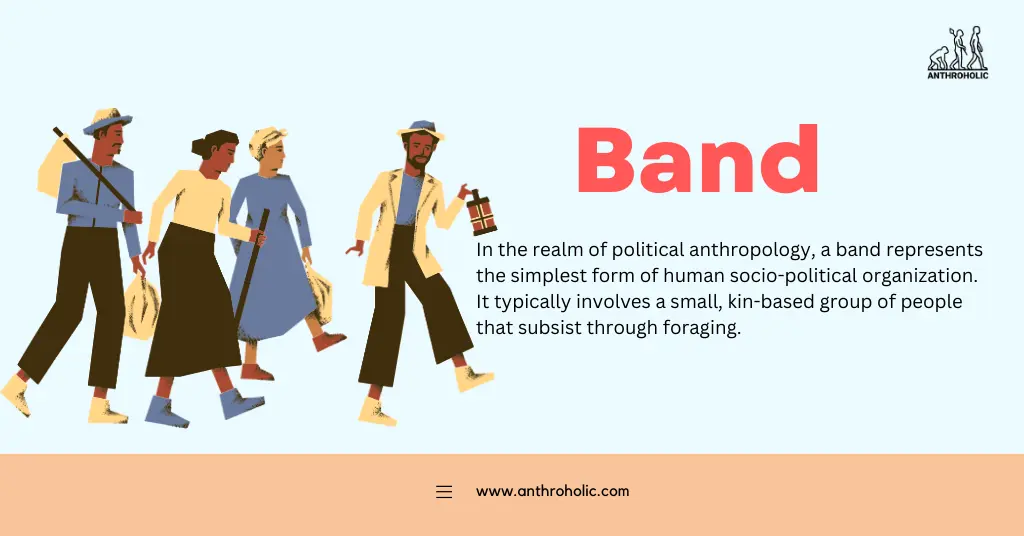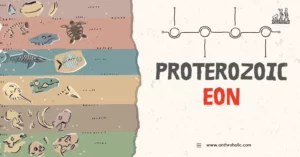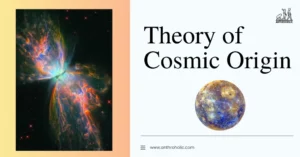AI Answer Evaluation Platform Live Now. Try Free Answer Evaluation Now
Band
In the realm of political anthropology, a band represents the simplest form of human socio-political organization. It typically involves a small, kin-based group of people that subsist through foraging.

Historical Perspective
The concept of a “band” as a socio-political structure emerged as early as the Paleolithic era, serving as the primary form of human organization until the advent of agriculture [1]. However, it’s important to note that not all foraging societies existed in the form of bands; various complexities can be observed in different cultural and ecological contexts.
Key Characteristics of Bands
A band’s structure is typically characterized by the following elements:
- Size: A band usually includes fewer than 100 individuals, often just a few dozen.
- Kinship: Members of a band are commonly interrelated, either through familial or marriage ties.
- Mobility: Bands are generally nomadic or semi-nomadic, frequently moving to exploit seasonally available resources.
- Leadership: Authority is typically egalitarian, with decisions made through consensus. Leadership roles exist but are non-hereditary and largely dependent on personal skills, rather than formal authority [2].
Comparison with Other Political Systems
| Political System | Size | Mobility | Leadership Style |
|---|---|---|---|
| Band | <100 | Nomadic | Egalitarian |
| Tribe | Several 100 | Semi-sedentary | Achieved status |
| Chiefdom | Thousands | Sedentary | Hereditary |
| State | Millions | Sedentary | Formalized Authority [3] |
Band vs Tribe
While both band and tribe share a kinship base, the tribal society typically comprises several bands. Tribal leadership is also distinct, often based on achieved status or elder councils, whereas band leadership is more informal.
Band vs Chiefdom
Chiefdoms contrast significantly with bands. They’re larger, sedentary, and have a clear, centralized, hereditary leadership structure. This system introduces social stratification, which is absent in bands.
Band vs State
State systems represent the most complex level of political organization, marked by large populations, formal leadership, and institutions to enforce laws.
Criticisms and Reinterpretations
Recent anthropological research has questioned the strict categorization of societies into bands, tribes, chiefdoms, and states, citing that these categories oversimplify the diverse nature of human societies [4]. Some also argue that the term ‘band’ carries outdated, Eurocentric views of foraging societies.
Anthropological Analysis of Bands: Case Studies
Hunter-Gatherer Bands in the Arctic
Among the classic examples of band societies are the Inuit, who inhabit the harsh Arctic regions. Their adaptations to the demanding environment have led to social organizations that are flexible and depend largely on kinship ties. These kin-based bands demonstrate both practical survival strategies and socio-cultural resilience in the face of extreme environmental conditions [5].
Key Features of Inuit Bands:
- Size: Typically comprises 20-50 individuals.
- Kinship: Strong emphasis on kinship and marital ties.
- Mobility: Seasonal migration patterns based on resource availability.
- Leadership: Informal and consensus-based, often centering on experienced hunters [6].
Bushmen Bands of the Kalahari Desert
The San people or Bushmen of the Kalahari Desert represent another quintessential band society. Despite the arid environment, the Bushmen have thrived for centuries due to their expert knowledge of their surroundings and resource management [7].
Key Features of Bushmen Bands:
- Size: Generally includes 20-50 members.
- Kinship: Predominantly kin-based with deep-rooted reciprocity norms.
- Mobility: Water availability and game migration dictate movement.
- Leadership: Decisions are reached through lengthy discussions; leaders are usually seasoned hunters or elderly individuals [8].
Influence of Band Societies on Modern Anthropology
Band societies, despite their relative simplicity, have profoundly influenced modern anthropological thought. From the groundbreaking Man the Hunter symposium in 1966 to modern anthropological discourses, the study of band societies has shed light on the evolution of human social, political, and economic systems [9]. This influence underscores the importance of the band as a unit of analysis in political anthropology.
Conclusion
While the concept of ‘band’ serves as a useful model for understanding human societies’ evolution, it is important to view it as a flexible framework rather than a rigid categorization. As researchers gather more data from contemporary and past societies, our understanding of these socio-political structures continues to evolve.
References
[1] Lee, Richard B., and Richard Daly, eds. (2005). The Cambridge Encyclopedia of Hunters and Gatherers. Cambridge: Cambridge University Press.
[2] Service, Elman R. (1962). Primitive Social Organization: An Evolutionary Perspective. New York: Random House.
[3] Carneiro, R.L. (1970). A Theory of the Origin of the State. Science.
[4] Kuper, Adam (2005). The Reinvention of Primitive Society: Transformations of a Myth. London: Routledge.
[5] Balikci, A. (1970). The Netsilik Eskimo. Garden City, NY: Natural History Press.
[6] Damas, D. (1984). “Central Eskimo: Introduction”. In Handbook of North American Indians, Volume 5: Arctic. Washington, D.C.: Smithsonian Institution.
[7] Lee, Richard B. (1979). The !Kung San: Men, Women, and Work in a Foraging Society. Cambridge: Cambridge University Press.
[8] Marshall, L. (1976). The !Kung of Nyae Nyae. Cambridge, MA: Harvard University Press.
[9] Lee, R. B., & DeVore, I. (Eds.). (1968). Man the Hunter. Chicago: Aldine Publishing Company.




